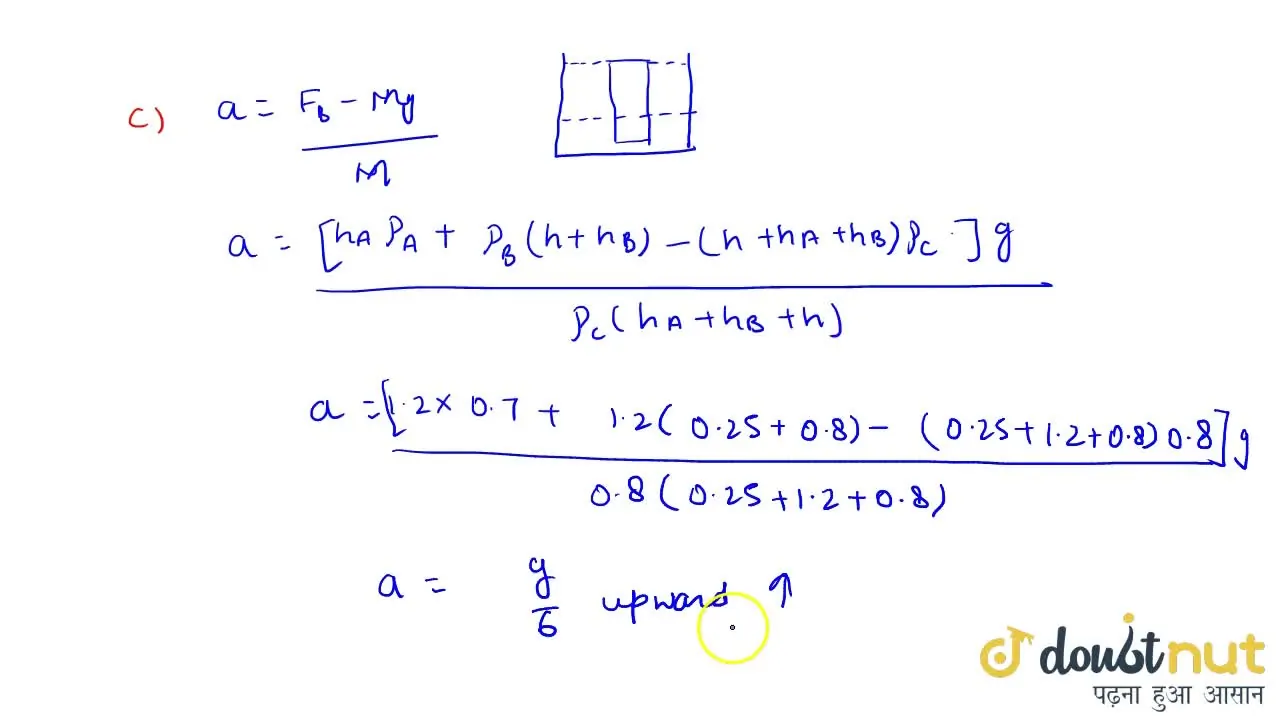A uniform solid cylinder of density 0.8g/cm3 floats in equilibrium in a combination of two non-mixing liquids A and B with its axis vertical.
The densities of the liquids A and B are 0.7g/cm3 and 1.2g/cm3, respectively. The height of liquid A is hA=1.2cm. The length of the part of the cylinder immersed in liquid B is hB=0.8cm.

(a) Find the total force exerted by liquid A on the cylinder.
(b) Find h, the length of the part of the cylinder in air.
(c) The cylinder is depressed in such a way that its top surface is just below the upper surface of liquid A and is then released. Find the acceleration of the cylinder immediately after it is released.
The correct Answer is:A, B, C
(a) As the pressure exerted by liquid A on the cylinder is radial and symmetric, the force due to this pressure cancels out and the net value is zero.
(b) For equilibrium, Buoyant force =weight of the body
⇒hAρAAg+hBρBAg=(hA+h+hB)AρCg
(where ρC= density of cylinder)
h=(hAρA+hBρBρC)−(hA+hB)=0.25cm
(c) a=(FBuoyant−MgM)
=[hAρA+ρB(h+hB)−(h+hA+hB)ρCρC(h+hA+hC)]g
=g6 upwards
Related Playlists
- BOOK - SUNIL BATRA (41 YEARS IITJEE PHYSICS)CHAPTER - MECHANICAL PROPERTIES OF MATTER AND FLUIDSEXERCISE - Subjective Problems1videos
MECHANICAL PROPERTIES OF MATTER AND FLUIDS
- BOOK - SUNIL BATRA (41 YEARS IITJEE PHYSICS)CHAPTER - LAWS OF MOTIONEXERCISE - JEE Main And Advanced79videos
LAWS OF MOTION
- BOOK - SUNIL BATRA (41 YEARS IITJEE PHYSICS)CHAPTER - MOMENTUM & IMPULSEEXERCISE - JEE Main And Advanced30videos
MOMENTUM & IMPULSE
Similar Questions
A jar contains two immiscible liquids A and B with a coin at its bottom. The depths of liquid A and liquid B are 6 cm and 8 cm, respectively. If the apparent depth of the coin is 9 cm and refractive index of liquid A is 1.5, what is the refractive index of liquid B?
View SolutionChoose the most appropriate options.
Argon crystallises in fcc arrangement and the density of solid and liquid Ar is 159g/cm3and1.42g/cm3, respectively. The percentage of empty space in liquid Ar isView SolutionA column of water 40cm height supports a 30cm column of an unknown liquid . What is the density of the liquid ?
View SolutionThe density of a liquid at 100∘C is 8.0g/cm3 and at 0∘C is 8.4g/cm3, the coefficient of cubical expansion of the liquid is
View SolutionTwo miscible liquids of densities 1.2gm/cm and 1.4gm/cm aer mixed with a proportion ratio of their volumes equal to 2.5: what is the density of redulting liquid?
View SolutionTwo identical tanks contain water and a liquid of density 0.8gcm−3. Pressure exerted by the liquid is equal to the pressure due to water column of 50 cm. Find the height of the liquid column in the tank ?
View SolutionTwo immiscible of densities 2.5g/cm3 and 0.8g/cm3 are taken in the ratio of their masses as 2:3 respectively find the average density of the liquid conbination.
View SolutionTwo identical containers A and B are filled with two different liquids of equal masses. The level of the liquid in container A is found to be one-fourth of the level of the liquid in container B. What is the ratio of thedensity of two liquids? If the density of he liquid in the container A is 2 " g "cm−3, then find the density of the mixture of the two liquids.
View SolutionAn object of relative density 0 . 75 is floating in a liquid with 500cm3 of the object inside the liquid . Find the total volume of the object, if the relative density of liquid is 1 . 0 2
View SolutionWhen 100 drops of a liquid P is added into a liquid Q the volume of the liquid in the container which is initially filled with liquid Q doubled. Determined density of the mixture if density of the liquids P and Q are 1.5 g cm ^(-3) and 1.3 g cm^(-3), respectively
View Solution


